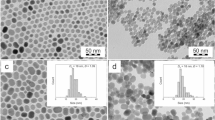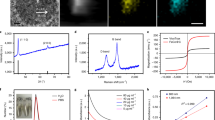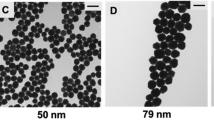Abstract
Functionalization of nanomaterials for precise biomedical function is an emerging trend in nanotechnology1. Carbon nanotubes are attractive as multifunctional carrier systems because payload can be encapsulated in internal space whilst outer surfaces can be chemically modified2. Yet, despite potential as drug delivery systems3,4 and radiotracers5,6,7,8, such filled-and-functionalized carbon nanotubes have not been previously investigated in vivo. Here we report covalent functionalization of radionuclide-filled single-walled carbon nanotubes and their use as radioprobes. Metal halides, including Na125I, were sealed inside single-walled carbon nanotubes to create high-density radioemitting crystals9 and then surfaces of these filled–sealed nanotubes were covalently modified with biantennary carbohydrates, improving dispersibility and biocompatibility10. Intravenous administration of Na125I-filled glyco-single-walled carbon nanotubes in mice was tracked in vivo using single-photon emission computed tomography. Specific tissue accumulation (here lung) coupled with high in vivo stability prevented leakage of radionuclide to high-affinity organs (thyroid/stomach) or excretion, and resulted in ultrasensitive imaging and delivery of unprecedented radiodose density. Nanoencapsulation of iodide within single-walled carbon nanotubes enabled its biodistribution to be completely redirected from tissue with innate affinity (thyroid) to lung. Surface functionalization of 125I-filled single-walled carbon nanotubes offers versatility towards modulation of biodistribution of these radioemitting crystals in a manner determined by the capsule that delivers them. We envisage that organ-specific therapeutics and diagnostics can be developed on the basis of the nanocapsule model described here.
This is a preview of subscription content, access via your institution
Access options
Subscribe to this journal
Receive 12 print issues and online access
$259.00 per year
only $21.58 per issue
Buy this article
- Purchase on Springer Link
- Instant access to full article PDF
Prices may be subject to local taxes which are calculated during checkout



Similar content being viewed by others
References
Weissleder, R. et al. Cell-specific targeting of nanoparticles by multivalent attachment of small molecules. Nature Biotechnol. 23, 1418–1423 (2005).
Martin, C. R. & Kohli, P. The emerging field of nanotube technology. Nature Rev. Drug Disc. 2, 29–37 (2003).
Wu, W. et al. Targeted delivery of Amphotericin B to cells by using functionalized carbon nanotubes. Angew. Chem. Int. Ed. 44, 6358–6362 (2005).
Prato, M., Kostarelos, K. & Bianco, A. Functionalized carbon nanotubes in drug design and discovery. Acc. Chem. Res. 41, 60–68 (2008).
Singh, R. et al. Tissue biodistribution and blood clearance rates of intravenously administered carbon nanotube radiotracer. Proc. Natl Acad. Sci. USA 103, 3357–3362 (2006).
McDevitt, M. R. et al. Tumor targeting with antibody-functionalized, radiolabeled carbon nanotubes. J. Nucl. Med. 48, 1180–1189 (2007).
Hartman, K. B., Hamlin, D. K., Wilbur, D. S. & Wilson, L. J. 211AtCl@US-tube nanocapsules: A new concept in radiotherapeutic-agent design. Small 3, 1496–1499 (2007).
Liu, Z. et al. In vivo biodistribution and highly efficient tumour targeting of carbon nanotubes in mice. Nature Nanotech. 2, 47–52 (2007).
Meyer, R. R. et al. Discrete atom imaging of one-dimensional crystals formed within single-walled carbon nanotubes. Science 289, 1324–1326 (2000).
Davis, B. G. Synthesis of glycoproteins. Chem. Rev. 102, 579–601 (2002).
Liu, Z. et al. Imaging the dynamic behaviour of individual retinal chromophores confined inside carbon nanotubes. Nature Nanotech. 2, 422–425 (2007).
Koshino, M. et al. Imaging of single organic molecules in motion. Science 316, 853 (2007).
Iezzi, E. B. et al. Lutetium-based trimetallic nitride endohedral metallofullerenes: New contrast agents. Nano Lett. 2, 1187–1190 (2002).
Koltover, V. K. in Progress in Fullerene Research (ed. Milton, L.) 199–233 (Nova, 2007).
Ohtsuki, T. et al. Insertion of Xe and Kr atoms into C60 and C70 fullerenes and the formation of dimers. Phys. Rev. Lett. 81, 967–970 (1998).
Shao, L., Tobias, G., Huh, Y. & Green, M. L. H. Reversible filling of single walled carbon nanotubes opened by alkali hydroxides. Carbon 44, 2855–2858 (2006).
Ballesteros, B. et al. Steam purification for the removal of graphitic shells coating catalytic particles and the shortening of single-walled carbon nanotubes. Small 4, 1501–1506 (2008).
Chen, J. et al. Solution properties of single-walled carbon nanotubes. Science 282, 95–98 (1998).
Chen, X. et al. Interfacing carbon nanotubes with living cells. J. Am. Chem. Soc. 128, 6292–6293 (2006).
Wu, P. et al. Biocompatible carbon nanotubes generated by functionalization with glycodendrimers. Angew. Chem. Int Ed. 47, 5022–5025 (2008).
Chen, X. et al. Boron nitride nanotubes are noncytotoxic and can be functionalized for interaction with proteins and cells. J. Am. Chem. Soc. 131, 890–891 (2009).
Tsang, S. C., Chen, Y. K., Harris, P. J. F. & Green, M. L. H. A simple chemical method of opening and filling carbon nanotubes. Nature 372, 159–162 (1994).
Nellist, P. D. & Pennycook, S. J. Direct imaging of the atomic configuration of ultradispersed catalysts. Science 274, 413–415 (1996).
Hong, S. Y. et al. Atomic-scale detection of organic molecules coupled to single-walled carbon nanotubes. J. Am. Chem. Soc. 129, 10966–10967 (2007).
Ballesteros, B., Tobias, G., Ward, M. A. H. & Green, M. L. H. Quantitative assessment of the amount of material encapsulated in filled carbon nanotubes. J. Phys. Chem. C 113, 2653–2656 (2009).
Kostarelos, K. The long and short of carbon nanotube toxicity. Nature Biotechnol. 26, 774–776 (2008).
Dwek, R. A. Glycobiology: Toward understanding the function of sugars. Chem. Rev. 96, 683–720 (1996).
Varki, A. Biological roles of oligosaccharides. Glycobiology 3, 97–130 (1993).
Sawa, M. et al. Glycoproteomic probes for fluorescent imaging of fucosylated glycans in vivo. Proc. Natl Acad. Sci. USA 103, 12371–12376 (2006).
Mazzaferri, E. L. in The Thyroid: A Fundamental and Clinical Text (eds Braverman, L. E. & Utiger, R. D.) 922–945 (Lippincott-Raven, 1996).
Spitzweg, C. et al. In vivo sodium iodide symporter gene therapy of prostate cancer. Gene Therapy 8, 1524–1531 (2001).
Lacerda, L. et al. Dynamic imaging of functionalized multi-walled carbon nanotube systemic circulation and urinary excretion. Adv. Mater. 20, 225–230 (2008).
Beekman, F. J. et al. Towards in vivo nuclear microscopy: Iodine-125 imaging in mice using micro-pinholes. Eur. J. Nucl. Med. Mol. Imaging 29, 933–938 (2002).
Marsee, D. K. et al. Inhibition of heat shock protein 90, a novel RET/PTC1-associated protein, increases radioiodide accumulation in thyroid cells. J. Biol. Chem. 279, 43990–43997 (2004).
Chen, C. L., Wang, Y., Lee, J. J. S. & Tsui, B. M. W. Toward quantitative small animal pinhole SPECT: Assessment of quantitation accuracy prior to image compensations. Mol. Imaging. Biol. 11, 195–203 (2009).
Hwang, A. B., Franc, B. L., Gullberg, G. T. & Hasegawa, B. H. Assessment of the sources of error affecting the quantitative accuracy of SPECT imaging in small animals. Phys. Med. Biol. 53, 2233–2252 (2008).
Kan, V. L. & Bennett, J. E. Lectin-like attachment sites on murine pulmonary alveolar macrophages bind Aspergillus fumigatus conidia. J. Infect. Dis. 158, 407–414 (1988).
Hickling, T. P. et al. Collectins and their role in lung immunity. J. Leukoc. Biol. 75, 27–33 (2004).
Kanke, M. et al. Clearance of 141Ce-labeled microspheres from blood and distribution in specific organs following intravenous and intraarterial administration in beagle dogs. J. Pharm. Sci. 69, 755–762 (1980).
Illum, L. et al. Blood clearance and organ deposition of intravenously administered colloidal particles. The effects of particle size, nature and shape. Int. J. Pharm. 12, 135–146 (1982).
Berndorff, D. et al. Radioimmunotherapy of solid tumors by targeting extra domain B fibronectin: Identification of the best-suited radioimmunoconjugate. Clin. Cancer Res. 11, 7053s–7063s (2005).
Liu, Z. et al. Circulation and long-term fate of functionalized, biocompatible single-walled carbon nanotubes in mice probed by Raman spectroscopy. Proc. Natl Acad. Sci. USA 105, 1410–1415 (2008).
Acknowledgements
We thank the Samsung Scholarship Foundation (S.Y.H.), the FP7 European Community Marie Curie ERG and Ramón y Cajal Programmes (G.T.), MICINN Spain (B.B.), INSS Japan (S.L-P.) and Thomas Swan Co. Ltd. (SWNTs and funding), and K. Doores, O. Pearce, J. Errey, W. Liu and M. A. Ward for technical assistance. R.B.S. is a member of the European Community CARBIO research training network. K.K. and K.T.A-J. would like to acknowledge partial funding of this work by the FP7 Anticarb (HEALTH-2007-201587) research programme. H.A-B. wishes to acknowledge the Ministère de l’Enseignement Supérieur et de la Recherche Scientifique (Algeria) for a full Ph.D. scholarship. B.G.D. is a Royal Society–Wolfson Research Merit Award recipient and is supported by an EPSRC LSI platform grant.
Author information
Authors and Affiliations
Contributions
S.Y.H., G.T., R.B.S., M.L.H.G., K.K. and B.G.D. designed the research, S.Y.H., G.T., K.T.A-J., B.B., H.A-B., S.L-P., C.F. and S.J.M. carried out the experiments, S.Y.H., G.T., K.T.A-J., H.A-B., B.B., S.L-P., P.D.N., R.B.S., S.J.M., M.L.H.G., K.K. and B.G.D. analysed the data and S.Y.H., G.T., K.T.A-J., K.K. and B.G.D. wrote the paper.
Corresponding authors
Ethics declarations
Competing interests
The authors declare no competing financial interests.
Supplementary information
Supplementary Information
Supplementary Information (PDF 6809 kb)
Rights and permissions
About this article
Cite this article
Hong, S., Tobias, G., Al-Jamal, K. et al. Filled and glycosylated carbon nanotubes for in vivo radioemitter localization and imaging. Nature Mater 9, 485–490 (2010). https://doi.org/10.1038/nmat2766
Received:
Accepted:
Published:
Issue Date:
DOI: https://doi.org/10.1038/nmat2766
This article is cited by
-
Applications of Graphene-Based Nanomaterials as Contrast Agents in Biomedical Imaging Technologies: A Review
Biomedical Materials & Devices (2023)
-
The dependence of 90Y sorption on nanodiamonds on sizes of their aggregates in water solutions
Journal of Radioanalytical and Nuclear Chemistry (2021)
-
A Review of Recent Progress on Nano MnO2: Synthesis, Surface Modification and Applications
Journal of Inorganic and Organometallic Polymers and Materials (2021)
-
Carbon nanotubes promote cell migration in hydrogels
Scientific Reports (2020)
-
Current outlook on radionuclide delivery systems: from design consideration to translation into clinics
Journal of Nanobiotechnology (2019)



